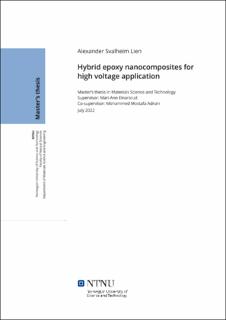| dc.contributor.advisor | Einarsrud, Mari-Ann | |
| dc.contributor.advisor | Adnan, Mohammed Mostafa | |
| dc.contributor.author | Lien, Alexander Svalheim | |
| dc.date.accessioned | 2022-10-13T17:20:03Z | |
| dc.date.available | 2022-10-13T17:20:03Z | |
| dc.date.issued | 2022 | |
| dc.identifier | no.ntnu:inspera:108213079:17948372 | |
| dc.identifier.uri | https://hdl.handle.net/11250/3026008 | |
| dc.description.abstract | Hybrid epoksy nanokompositter med uorganiske TiO2 eller Al2O3 nanopartikler som fyllmateriale har vist seg å ha utmerkede dielektriske egensk-\\aper og kan bli brukt som isolasjon i høyspenningsapplikasjoner. Epoksy nanokompositter kan bli syntetisert enten med ex situ methoden, der de uorganiske nanopartiklene er syntetisert på forhånd og mekanisk blandet med epoksy monomeren, eller in situ metoden, der de uorganiske nanopartiklene gror og nukleeres inni epoksy matriksen. Hybrid epoksy nanokompositter som blir produsert med ex situ metoden er vanligvis gjort ved å blande nanopartiklene med den viskøse epoksy monomeren. I dette arbeidet, ex situ syntesemetoden var adaptert ved å først blande nanopartiklene med herdemiddelet og deretter blande herdemiddelløsningen med epoksy monomeren. Nanopartiklene i epoksy nanokompositter syntetisert med ex situ metoden agglomererer ofte så spredningen av nanopartiklene er en utfordring. TiO2 og Al2O3 nanopartikler ble overflatefunksjonalisert med (3-aminopropyl)triethoxysilane (APTES) for å redusere agglomerasjon og øke spredningen av nanopartiklene i epoksy polymeren. \\
En kvalitativ analyse var utført med Fourier transform infrarød spektroskopi og Raman spektroskopi som viste at funksjonaliseringen av nanopartiklene var vellykket ved observasjon av karakteristiske bånd som kun finnes i APTES. Termogravimetrisk analyse viste at overflatedekningen av APTES på TiO2 og Al2O3 nanopartiklene var henholdsvis 30.9 og 43.1 %. Avbildning av epoksy nanokomposittene på nanoskala viste at agglomerater hadde blitt dannet, og at de hadde størrelser fra 30 nm til 1 mikrometer. Bilder med lav forstørrelse viste at agglomeratene ikke hadde god spredning i epoksy polymeren med frie veilengder opp til 800 nm. Imidlertid, epoksy nanokomposittene med funksjonaliserte nanopartikler hadde generelt bedre spredning og mindre agglomerater enn epoksy nanokompositter med ufunkasjonaliserte nanopartikler. Dette betyr at funksjonalisering av nanopartiklene hadde en positiv effekt med tanke på agglomeratstørrelse og spredning i epoksy nanokomposittene. Impedansspektroskopi viste at de dielektriske egenskapene av ren epoksy var generelt bedre enn epoksy nanokomposittene. Noen av epoksy nanokomposittene med lav fyllmengde hadde derimot ønskede dieletriske egenskaper med lavere relativ permittivitet og dielektrisk tap i forhold til ren epoksy. I tillegg, epoksy nanokompositter med funksjonaliserte nanopartikler hadde generelt lavere permittivitet sammenliknet med epoksy nanokompositter som ble syntetisert med ufunksjonaliserte nanopartikler. Differensiell skanning kalorimetri viste at inkorporering av nanopartikler ved lave fyllmengder resulterte i en reduksjon av glassovergangstemperaturen, Tg, sammenliknet med ren epoksy og at Tg økte med en økning av fyllmengden i epoksy nanokomposittene. I tillegg, epoksy nanokompositter syntetisert med funksjonaliserte nanopartikler hadde høyere Tg sammenliknet med epoksy nanokompositter med ufunksjonaliserte nanopartikler. | |
| dc.description.abstract | Hybrid epoxy nanocomposites with TiO2 or Al2O3 nanoparticles as filler have proven to have excellent dielectric properties which can be utilized in high voltage insulation applications. Epoxy nanocomposites can be synthesized by either the ex situ method, where the inorganic nanoparticles are pre-synthesized and mechanically mixed with the epoxy monomer, or the in situ method, where the inorganic nanoparticles are grown and nucleated within the epoxy matrix. Traditionally, producing hybrid epoxy nanocomposites by the ex situ method is done by mechanically mixing the nanoparticles with the highly viscous epoxy monomer. In this work, the ex situ synthesis method was adapted by first mixing the nanoparticles with the curing agent and then mixing the curing agent dispersion with the epoxy monomer. The reason for this is that the curing agent is much less viscous than the epoxy. Ex situ synthesized epoxy nanocomposites often have the inorganic nanoparticles agglomerated in the epoxy matrix as dispersion is a challenge. Surface functionalization by (3-aminopropyl)triethoxysilane (APTES) was performed on as-received TiO2 and Al2O3 nanoparticles to reduce agglomeration of the nanoparticles and to increase the dispersion of the nanoparticles in the epoxy polymer. \\
A qualitative analysis by Fourier transform infrared- and Raman spectroscopy showed that the functionalization of the nanoparticles was successful by the presence of characteristic bands from APTES. Thermogravimetric analysis revealed that APTES surface coverage of functionalized TiO2 and Al2O3 was 30.9 and 43.1 % respectively. Nanoscale imaging showed that agglomerates had formed in the epoxy nanocomposites ranging from 30 nm up to 1 micrometer in size and low magnification images revealed that the agglomerates were not well-dispersed in the epoxy with free path lengths up to 800 nm. However, the epoxy nanocomposites with functionalized nanoparticles generally were more well-dispersed and had smaller agglomerates on average compared to epoxy nanocomposites with as-received nanoparticles. This shows that functionalizing the nanoparticles had a positive effect with respect to agglomerate size and dispersion of the epoxy nanocomposites. Impedance spectroscopy showed that the dielectric properties of the pure epoxy was generally better than epoxy nanocomposites. However, some of the epoxy nanocomposites at low filler content exhibited desirable dielectric properties with lower permittivity and dielectric loss than pure epoxy. Furthermore, epoxy nanocomposites with functionalized oxide nanoparticles generally had lower permittivity compared to epoxy nanocomposites synthesized with as-received oxide nanoparticles. Differential scanning calorimetry revealed that incorporation of oxide nanoparticles at low filler content resulted in a decrease in the glass transition temperature, Tg, compared to pure epoxy and that Tg increased with increasing filler content in the epoxy nanocomposites. Additionally, epoxy nanocomposites synthesized with functionalized oxide nanoparticles had a higher Tg compared to their as-received counterparts. | |
| dc.language | eng | |
| dc.publisher | NTNU | |
| dc.title | Hybrid epoxy nanocomposites for high voltage application | |
| dc.type | Master thesis | |
